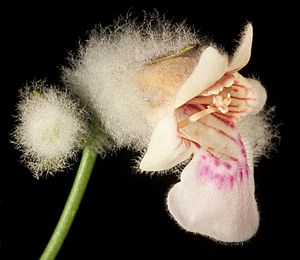Quoya loxocarpa facts for kids
Quick facts for kids Quoya loxocarpa |
|
|---|---|
 |
|
| Scientific classification | |
| Genus: |
Quoya (plant)
|
| Species: |
loxocarpa
|
 |
|
| Synonyms | |
Quoya loxocarpa is a unique flowering plant that belongs to the mint family called Lamiaceae. You can find it growing naturally in parts of Western Australia and the Northern Territory. This plant is an open shrub with many thin, tangled branches. Its leaves are shaped like oblongs and feel woolly when they are young. The flowers are a pretty whitish-pink with purple spots inside, and they are surrounded by fuzzy, woolly parts called sepals.
Contents
What Quoya loxocarpa Looks Like
Quoya loxocarpa is an open shrub with many thin, crisscrossing branches. Most of these branches grow from the bottom of the plant. The leaves are shaped like ovals or oblongs, and sometimes they are almost round. They are about 1–4 centimetres (0.39–1.6 in) long and 1–3 cm (0.39–1.2 in) wide. Often, their edges are wavy or have uneven teeth. When the leaves are young, they have soft, woolly hairs. But as they get older, they become smooth, which is called glabrous.
The Flowers of Quoya loxocarpa
The flowers grow in the upper part of where a leaf meets the stem, which is called the leaf axil. They usually appear in groups of 3 to 7 flowers on a thin stalk that is about 2.5–8 mm (0.098–0.31 in) long. At the base of these flower groups, there are small, leaf-like parts called bracts. These bracts are about 3–5 mm (0.12–0.20 in) long and are woolly on the outside. There are also even smaller parts called bracteoles.
The plant has five sepals, which are like small leaves that protect the flower bud. They are about 4–6 mm (0.16–0.24 in) long and form a tube at their base, about 1–2 mm (0.039–0.079 in) long. At the end of this tube, there are thin, spear-shaped tips. The outside of the sepal tube is covered with thick, purplish, woolly hairs, but the inside is smooth.
The petals are whitish-pink with purple spots inside the flower's opening. They are about 12–20 mm (0.47–0.79 in) long and form a tube with a wide opening. This tube has five short, wide lobes or sections. The lowest lobe is very wide and almost round, about 5–8 mm (0.20–0.31 in) long and 7–11 mm (0.28–0.43 in) wide. The other four lobes are about half that size and look similar to each other. The outside of the petal tube has short, soft hairs, but the inside is smooth. The only exception is a ring of hairs around the ovary (where seeds develop) and a few long hairs on the largest petal lobe.
The flower has four stamens, which are the parts that produce pollen. These stamens are shorter than the petal tube. The two upper stamens are much shorter than the two lower ones. Quoya loxocarpa mainly flowers from July to November. After flowering, it produces fruits that are curved and oval-shaped, about 2.5–3 mm (0.098–0.12 in) long, with the sepals still attached.
How Quoya loxocarpa Got Its Name
Naming History
This plant was first officially described in 1860 by a scientist named Ferdinand von Mueller. He gave it the name Chloanthes loxocarpa. His description was published in a book called Fragmenta phytographiae Australiae. He studied a plant sample collected by Augustus Oldfield near the Murchison River.
Later, in 1917, another scientist named George Druce changed the name to Pityrodia loxocarpa. But in 2011, Barry Conn and Murray Henwood changed the name again to Quoya loxocarpa. They published this new name in a scientific journal called Australian Systematic Botany.
Meaning of the Name
The second part of the plant's scientific name, loxocarpa, comes from two Ancient Greek words. The word loxos means "slanting," and karpos means "fruit." So, the name loxocarpa likely refers to the fruit's slanted or curved shape.
Where Quoya loxocarpa Grows
This type of quoya plant mostly grows in areas with shrubs, especially in coastal regions where there is sand over limestone. However, it can also be found further inland near places like Wiluna and Carnegie. It also grows near the border with South Australia and the Northern Territory. There are a few records of it growing in the Northern Territory.
Conservation Status
The Western Australian Government's Department of Parks and Wildlife has classified Quoya loxocarpa as "not threatened." This means that the plant is not currently in danger of disappearing.

